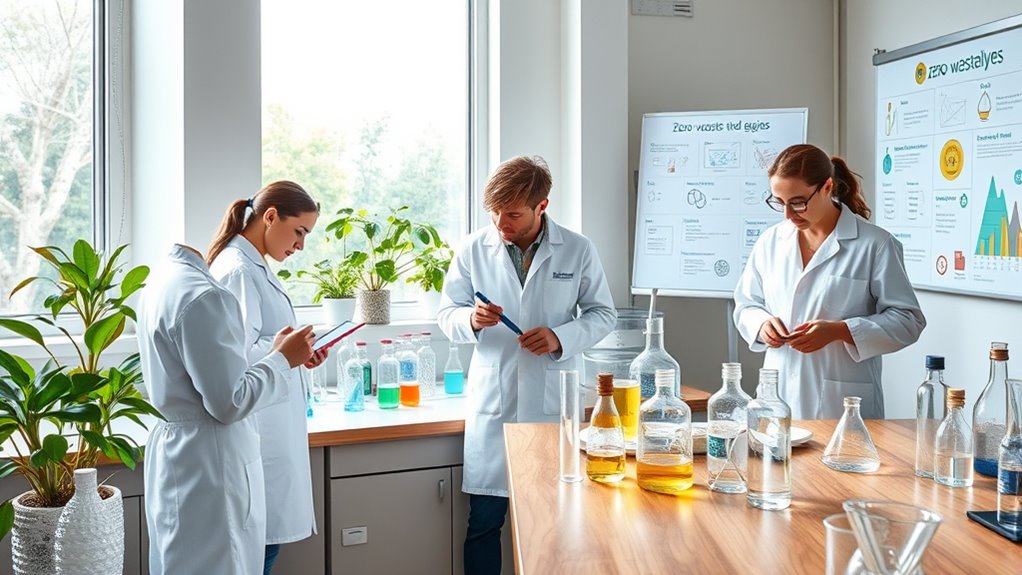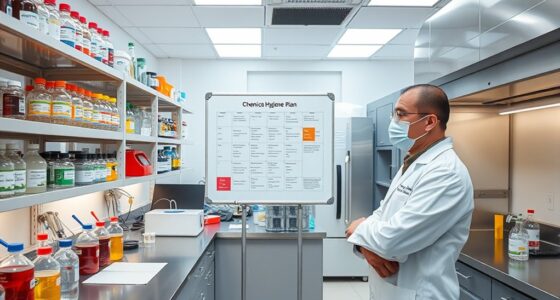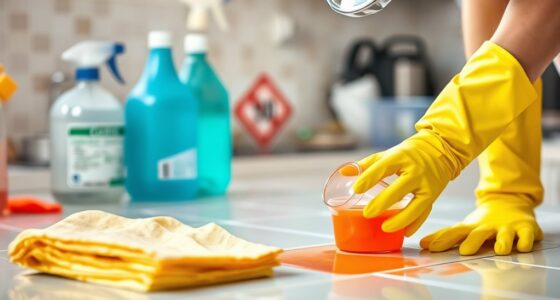To develop a zero-waste chemistry teaching lab, start by evaluating your chemical needs carefully, minimizing excess usage, and choosing reusable materials like glassware and stainless steel tools. Design experiments that cut down on waste, incorporate green chemistry principles, and use digital tools to reduce paper. Engage students in waste segregation and responsible disposal, fostering a culture of sustainability. Keep exploring these strategies to create an environmentally friendly and safe lab environment.
Key Takeaways
- Optimize chemical inventory, storage, and usage to reduce waste and prevent over-purchasing.
- Incorporate reusable materials and equipment, maintaining them through proper cleaning and handling.
- Design experiments that minimize material use, utilize green solvents, and leverage digital tools to decrease resource consumption.
- Engage students in waste audits and education to foster responsible disposal, sustainability awareness, and eco-friendly practices.
- Establish clear waste segregation protocols, ensure proper disposal procedures, and promote a safety culture focused on waste reduction.
Assessing and Minimizing Chemical Usage

To effectively reduce chemical waste in your teaching labs, you need to start by evaluating current chemical usage. Review which chemicals are used most frequently and identify any excess or outdated stock. This step enhances lab safety by preventing accidental spills or reactions caused by improper storage. Proper chemical storage is vital; ensure chemicals are stored according to compatibility and hazard class to minimize risks. Consider using inventory management tools to track quantities and expiration dates, helping you avoid over-purchasing. Reducing unnecessary chemicals not only cuts waste but also fosters a safer environment for students and staff. Regularly assess your chemical inventory and usage patterns to optimize storage and minimize waste, setting the foundation for a more sustainable laboratory. Chemical safety is essential for a successful zero-waste approach. Incorporating regulatory compliance can further ensure your lab adheres to safety standards and reduces potential liabilities. Additionally, utilizing data analytics can help you identify usage trends and optimize ordering processes for better resource management.
Implementing Reusable Materials and Equipment
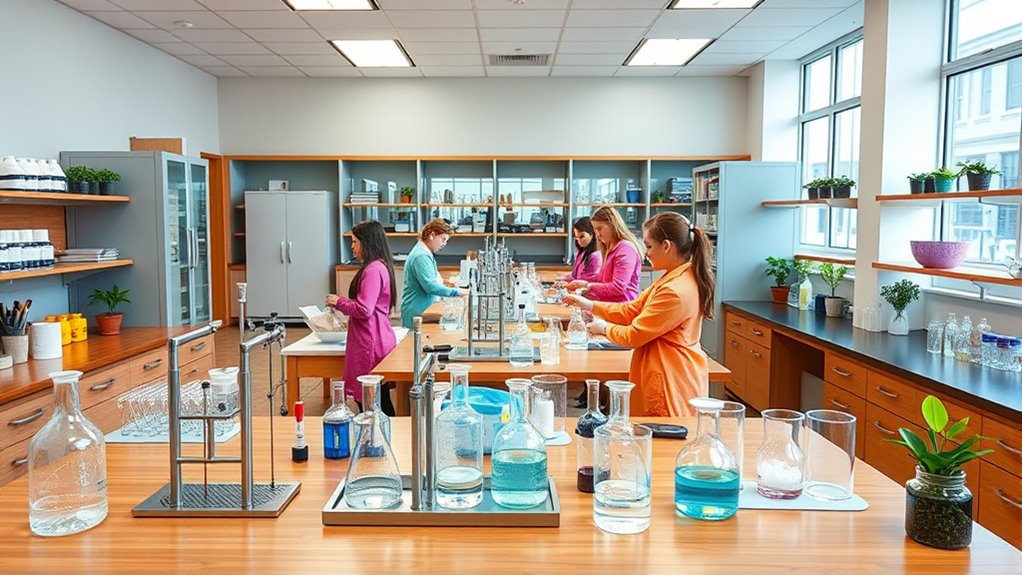
Implementing reusable materials and equipment offers a practical way to cut down on chemical waste and reduce environmental impact in your teaching labs. By choosing durable glassware, stainless steel tools, and other long-lasting items, you minimize single-use disposables. This approach also enhances lab safety, as well-maintained equipment reduces the risk of breakage or contamination. Regular equipment maintenance ensures that tools function properly and stay clean, preventing accidents and inaccuracies in experiments. Be sure to establish cleaning protocols that preserve the integrity of reusable materials. Incorporating reusable items not only cuts waste but also fosters a culture of sustainability and responsibility among students. Understanding the importance of laboratory safety and proper maintenance is essential for effective implementation. Additionally, being aware of Bitcoin IRA concepts related to asset management can inspire innovative approaches to resource utilization and waste reduction. Recognizing the antioxidant properties of natural products like honey can motivate students to explore eco-friendly and health-conscious alternatives in their experiments. With careful attention to lab safety and maintenance, you can make your teaching labs more eco-friendly without sacrificing quality.
Optimizing Experimental Designs for Waste Reduction
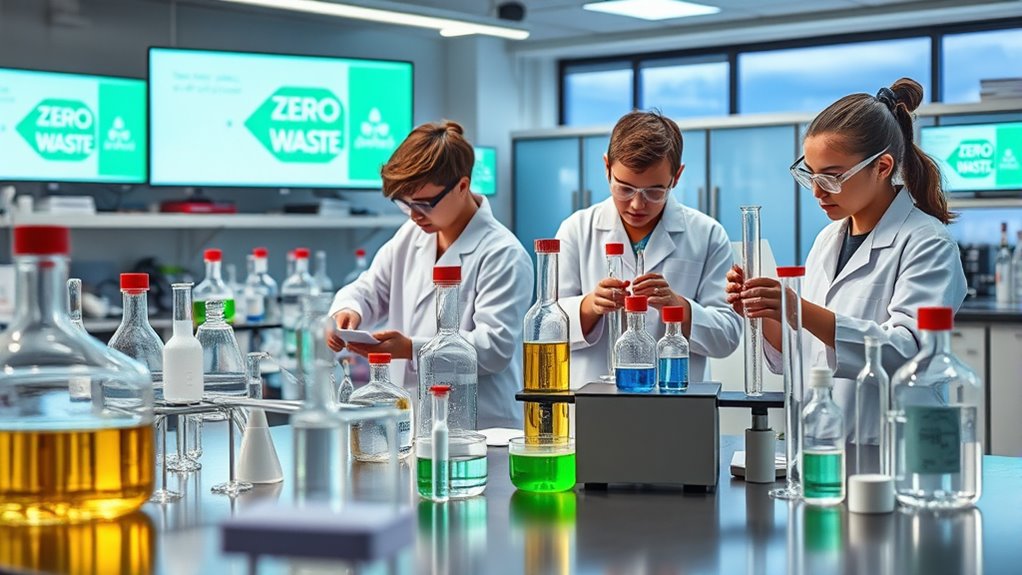
By carefully designing experiments to maximize data collection while minimizing material use, you can substantially reduce chemical waste in your teaching labs. Start by adopting innovative lab layouts that streamline workflows and reduce unnecessary steps, saving both materials and time. Use digital documentation to track procedures, results, and deviations precisely, eliminating the need for excess paper and reducing errors that lead to waste. Simplify experimental setups to focus on essential reactions, avoiding overuse of reagents and supplies. Incorporate multi-purpose equipment and scalable protocols to adapt experiments for different class sizes without increasing waste. Additionally, understanding resource management principles can guide you in optimizing supply use and minimizing excess. Applying sustainable practices can further enhance the environmental impact of your lab operations. Implementing waste reduction strategies in your lab design can further enhance sustainability and efficiency. By refining your experimental designs with these strategies, you promote efficient resource use, foster sustainability, and create a more environmentally responsible learning environment.
Promoting Proper Waste Segregation and Recycling
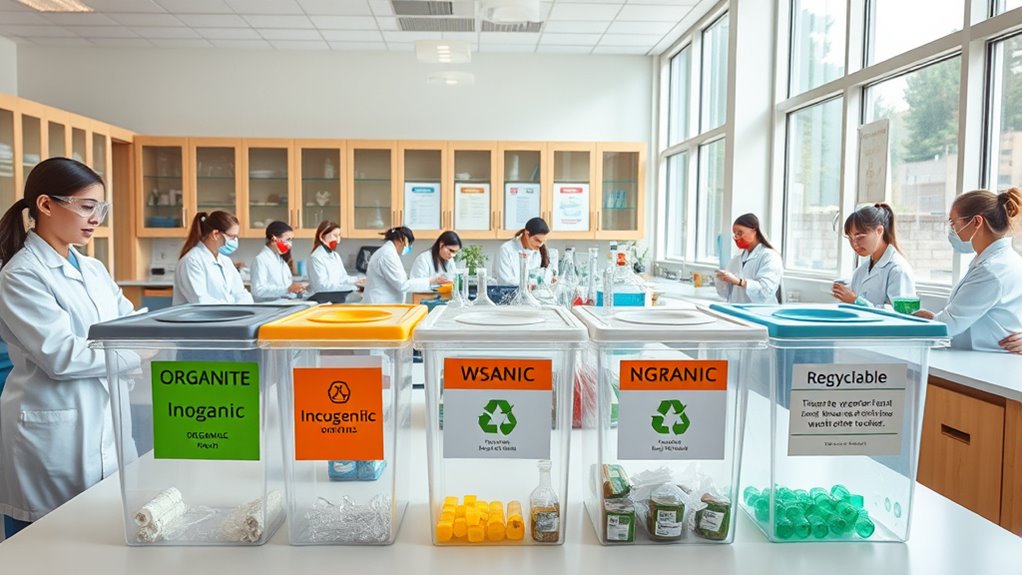
Effective waste segregation is essential for minimizing environmental impact in your teaching labs. Properly separating chemical waste ensures chemical safety and prevents dangerous reactions. Use clearly labeled containers for different waste types, such as organic, inorganic, and hazardous chemicals. Encourage students to dispose of waste promptly and correctly, reducing contamination risks. Incorporate waste composting for biodegradable materials like paper towels and food scraps, promoting sustainability. Make sure recycling stations are accessible and well-marked, emphasizing the importance of recycling plastics, glass, and metals. Educate students about the significance of waste segregation to foster responsible habits. Incorporating proper waste management strategies aligns with zero-waste principles and reduces overall environmental footprint. When everyone participates actively, you create a safer, cleaner, and more environmentally friendly lab environment aligned with zero-waste principles. Additionally, providing proper waste disposal training helps students understand the environmental benefits of responsible waste practices. Engaging students in understanding creative practice concepts such as waste reduction can further reinforce sustainable behaviors and inspire innovative solutions for environmental challenges.
Incorporating Green Chemistry Principles Into Curriculum
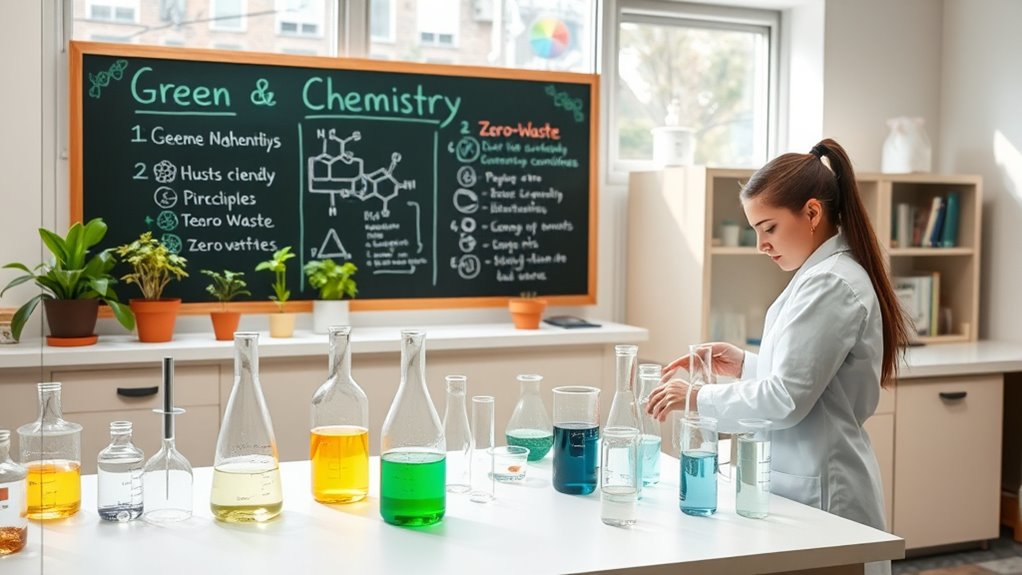
You can integrate green chemistry principles into your curriculum by exploring relevant frameworks and concepts. Designing sustainable experiments that minimize waste and environmental impact helps students apply these ideas practically. Additionally, numerous educator resources and tools are available to support effective and engaging green chemistry instruction. Incorporating eco-friendly practices into lab activities further reinforces the importance of sustainability in scientific work. Teaching students about nutritional advantages of green juice can also highlight real-world applications of green chemistry concepts. Recognizing the environmental benefits of sustainable practices can inspire students to adopt eco-conscious habits beyond the classroom.
Green Chemistry Frameworks
Integrating green chemistry principles into the curriculum provides a structured framework that guides students toward more sustainable laboratory practices. This approach emphasizes reducing waste, avoiding hazardous substances, and designing safer experiments. By incorporating green chemistry frameworks, you help students understand the importance of laboratory safety and proper chemical storage, minimizing risks associated with hazardous materials. These frameworks encourage critical thinking about the lifecycle of chemicals, promoting safer handling and disposal methods. They also highlight the importance of selecting less toxic reagents and designing experiments that produce minimal waste. Teaching students these principles fosters a mindset focused on sustainability and safety, which can influence their future research and professional practices. Understanding bike tire pressure and how it impacts performance can serve as an analogy for proper chemical handling and optimization in the lab. Additionally, emphasizing chemical lifecycle assessment encourages students to consider environmental impacts from synthesis to disposal. Overall, green chemistry frameworks serve as a foundation for cultivating environmentally responsible chemists.
Sustainable Experiment Design
Designing sustainable experiments involves intentionally applying green chemistry principles to minimize environmental impact while maintaining educational value. Start by selecting green solvents that are less toxic, biodegradable, and derived from renewable resources to reduce hazardous waste. Incorporate energy-efficient heating methods, such as using insulated setups or microwave-assisted reactions, to lower energy consumption. Simplify procedures to reduce reagent use and waste generation without compromising learning outcomes. Incorporate energy-efficient heating methods to minimize energy use and promote sustainability in the laboratory. Utilize waste reduction techniques to further decrease the environmental footprint of laboratory activities. Select experiments that demonstrate real-world applications of sustainability, emphasizing the importance of resource conservation. Additionally, selecting experiments that utilize Gold IRA principles can highlight economic sustainability in chemistry practices to reinforce environmentally responsible choices. By thoughtfully integrating green solvent choices and energy-efficient heating, you can create experiments that are both environmentally responsible and effective for student learning. This approach fosters awareness of sustainable practices and encourages future environmentally conscious chemists.
Educator Resources and Tools
To effectively incorporate green chemistry principles into the curriculum, you can access a variety of resources and tools designed to support sustainable teaching practices. Digital simulations and virtual labs offer interactive ways to demonstrate green chemistry concepts without physical waste or hazardous materials. These tools allow students to experiment with reaction pathways, analyze environmental impacts, and explore sustainable alternatives in a risk-free environment. Many online platforms provide ready-made modules aligned with green chemistry principles, making it easier to integrate sustainability into your lessons. By using virtual labs, you can engage students actively while minimizing resource consumption. These digital resources are flexible, accessible, and cost-effective, helping you foster environmentally conscious chemistry education effectively. Additionally, vetted educational resources can provide trusted guidance and best practices for implementing these innovative approaches.
Encouraging Student Involvement and Responsibility
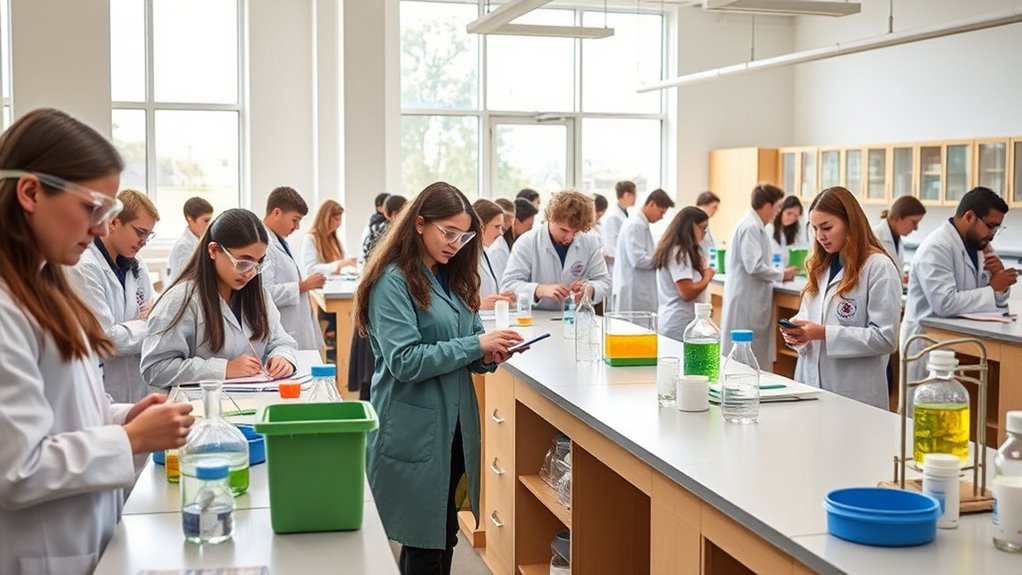
Encouraging students to lead waste audits empowers them to identify and reduce lab waste actively. When students take personal responsibility, they become more motivated to implement sustainable practices. You can foster this by involving them in audits and emphasizing their role in creating a greener lab environment. Incorporating behavioral analytics can further help students understand their impact on lab sustainability. Additionally, providing feedback based on performance metrics can motivate continuous improvement in waste reduction efforts.
Student-Led Waste Audits
By empowering students to lead waste audits, you foster a sense of ownership and responsibility in managing lab waste. When students take charge, they become more aware of chemical safety protocols and the importance of minimizing hazardous waste. As they assess disposal practices, they also become mindful of laboratory ergonomics, ensuring that waste handling is efficient and safe. Conducting student-led audits encourages critical thinking about waste reduction strategies and highlights areas where improvements are needed. This active involvement helps students see the real-world impact of sustainable practices while reinforcing safety measures. Ultimately, giving students control of waste audits promotes a proactive attitude toward environmental responsibility and safe lab operations, making zero-waste chemistry a shared goal.
Promoting Personal Accountability
Empowering students to take responsibility for their waste management efforts builds a culture of personal accountability in the lab. When students understand that their actions directly impact chemical safety and lab organization, they become more engaged and conscientious. Encourage them to develop routines for proper waste segregation and to monitor their own disposal practices. Assign clear roles to foster ownership, such as managing waste containers or cleaning work areas. By involving students in decision-making about reducing waste, you promote a sense of responsibility. This active involvement not only minimizes hazards but also reinforces good habits, ensuring they recognize their role in maintaining a safe and efficient lab environment. Personal accountability becomes ingrained when students see their contributions as essential to overall safety and sustainability.
Establishing Protocols for Safe Waste Disposal
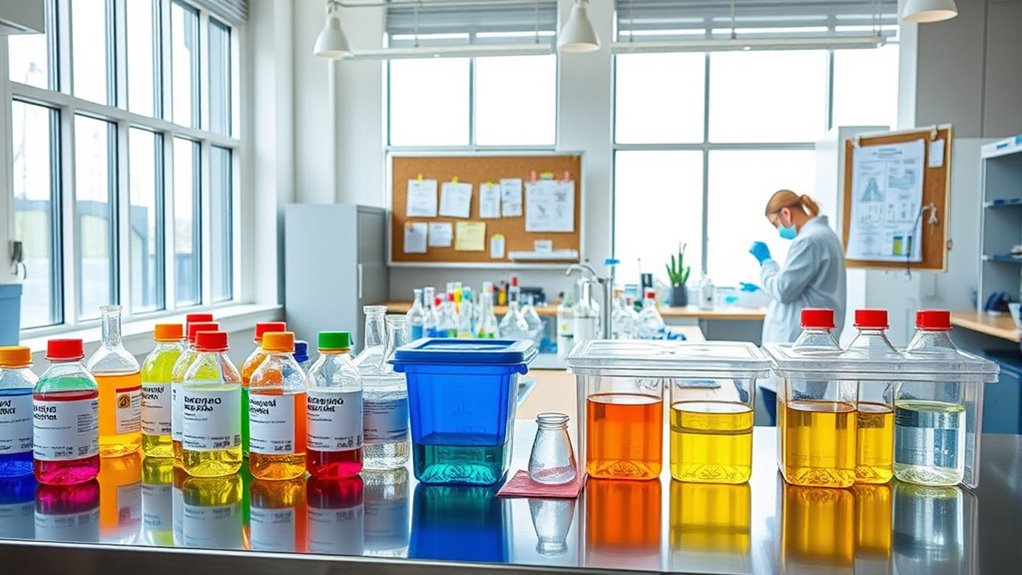
Establishing clear protocols for waste disposal is essential to guarantee safety and environmental responsibility in zero-waste chemistry labs. You should prioritize chemical spill prevention by training students on proper handling and cleanup procedures, reducing the risk of accidents. Implement strict hazardous material labeling to ensure everyone recognizes and understands the hazards of waste containers. Clearly mark waste types and disposal instructions to prevent cross-contamination and unsafe practices. Regularly review and update disposal protocols, involving students in the process for better adherence. Also, establish designated disposal stations with appropriate containment to minimize spills. By maintaining consistent procedures, you foster a safer lab environment and support zero-waste goals while protecting students, staff, and the environment.
Frequently Asked Questions
How Can Faculty Effectively Train Students in Zero-Waste Techniques?
You can effectively train students in zero-waste techniques by incorporating hands-on demonstrations that show real-world applications and reinforce learning. Encourage peer mentorship, where experienced students guide newcomers, fostering a collaborative environment. This approach builds confidence and practical skills, making waste reduction strategies more engaging and memorable. By actively involving students and promoting peer support, you help create a sustainable mindset and guarantee the techniques are understood and adopted effectively.
What Funding Options Support Sustainable Chemistry Lab Initiatives?
Funding options for sustainable chemistry lab initiatives are like a toolbox full of opportunities. You can explore grant opportunities from government agencies, environmental foundations, and educational institutions that prioritize green practices. Sponsorship options from local businesses or industry partners also support zero-waste projects. These resources help you implement innovative, eco-friendly lab techniques, making sustainability achievable and inspiring students to embrace environmental responsibility in their scientific pursuits.
How to Measure the Environmental Impact of Waste Reduction Strategies?
To measure the environmental impact of waste reduction strategies, you should conduct a life cycle analysis to evaluate the overall environmental burden from start to finish. Additionally, perform carbon footprint measurement to quantify greenhouse gas emissions associated with your lab activities. These methods help you identify improvements, track progress over time, and guarantee your waste reduction efforts genuinely benefit the environment, guiding more sustainable chemistry teaching practices.
Are There Specific Certifications for Zero-Waste Chemistry Labs?
Think of zero-waste labs as a quest for the Holy Grail of sustainability. While there aren’t universal certifications specifically for zero-waste chemistry labs, you can pursue green lab accreditation programs that set certification standards for eco-friendly practices. These certifications recognize your commitment to reducing waste and minimizing environmental impact, helping you showcase your lab’s sustainability efforts and inspiring others to follow suit in their pursuit of greener science.
How Can Partnerships With Local Organizations Enhance Waste Reduction Efforts?
You can enhance waste reduction efforts by partnering with local organizations, fostering community engagement and resource sharing. These partnerships allow you to access expert knowledge, share best practices, and pool resources for waste management. By working together, you create a network that supports sustainable practices, encourages innovation, and amplifies your impact. This collaborative approach makes zero-waste chemistry labs more effective, inspiring broader community participation and long-term environmental benefits.
Conclusion
By embracing these zero-waste strategies, you’ll transform your chemistry labs into sustainable spaces where waste diminishes like mist at dawn. You’ll not only minimize environmental impact but also cultivate responsible future scientists. Remember, every small change acts as a ripple—turning your lab into a beacon of green innovation. Together, you and your students can make chemistry a catalyst for positive change, proving that even the tiniest drop can create waves of sustainability.
